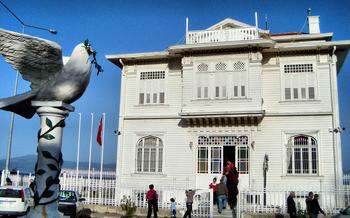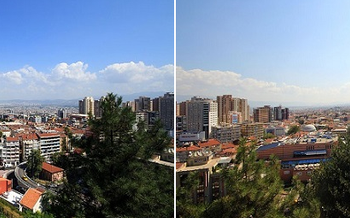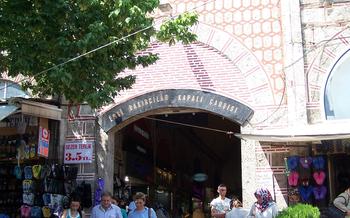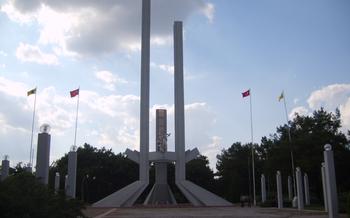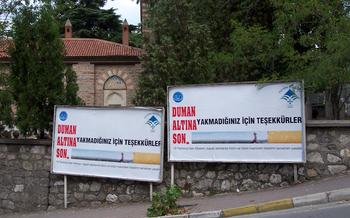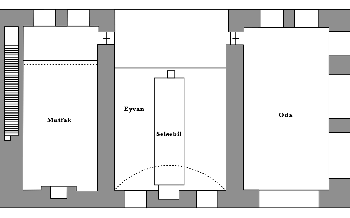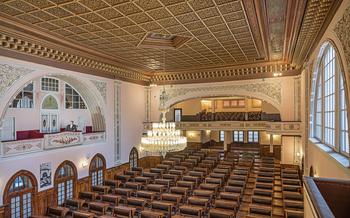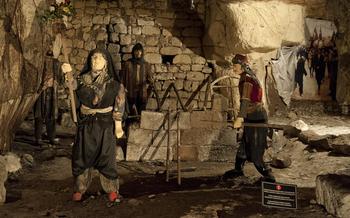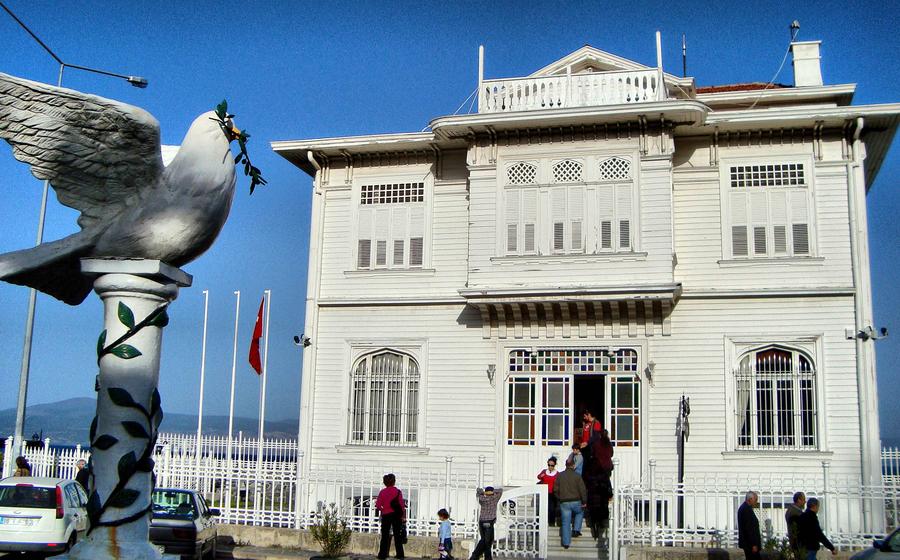
Mudanya Armistice House Museum
- Historical Significance
- Location and Accessibility
- Architectural Features
- Museum Exhibits
- Historical Artifacts
- Interactive Displays
- Guided Tours
- Admission Fees and Hours of Operation:
- Photography and Videography
- Museum Shop and Souvenirs
- Educational Programs and Workshops
- Temporary Exhibitions and Events
- Historical Context and Significance
- Insider Tip:
Historical Significance
The Mudanya Armistice House Museum holds immense historical significance as the site where the Mudanya Armistice was signed on October 11, 1922, marking the end of the Greco-Turkish War of 1919-192The armistice negotiations took place in this very building, between representatives of the Turkish National Movement led by Mustafa Kemal Atatürk and the Allied Powers. The armistice paved the way for the subsequent Treaty of Lausanne in 1923, which formally recognized the independence of the newly founded Turkish Republic and established its borders. The Mudanya Armistice thus played a crucial role in shaping the course of modern Turkish history.
Location and Accessibility
The Mudanya Armistice House Museum is conveniently located in the heart of Mudanya, a charming town on the shores of the Sea of Marmara. The exact address of the museum is Cevdet Sunay Bulvarı, No: 10, Mudanya, Bursa.
Reaching the museum is a breeze, whether you choose to use public transportation or your own vehicle. If you opt for public transport, simply hop on a bus or ferry to Mudanya from Bursa city center. Once in Mudanya, you can take a short walk or catch a taxi to the museum.
For those driving, the journey is equally straightforward. From Bursa, follow the signs to Mudanya and drive along the scenic coastal road. The Mudanya Armistice House Museum is well-signposted, so you won't have any trouble finding it.
The museum's proximity to other tourist attractions in Bursa makes it an ideal stop on a comprehensive tour of the city. After exploring the Mudanya Armistice House, you can visit nearby attractions such as the Mudanya Ferry Port, the Mudanya Clock Tower, and the Mudanya Bazaar.
Architectural Features
The Mudanya Armistice House, a splendid manifestation of early 20th-century architecture, stands as a testament to the enduring legacy of the Mudanya Armistice. Constructed in 1906, the building showcases an eclectic blend of architectural styles, harmoniously merging Ottoman and European influences.
The exterior façade captivates with its elegant symmetry, featuring bay windows that gracefully protrude from the building, adorned with intricate wooden balconies. These balconies, a hallmark of Ottoman architecture, add a touch of grandeur to the building's overall aesthetic. The spacious verandas, supported by slender columns, invite visitors to bask in the Mediterranean breeze while contemplating the historic significance of the site.
The interior of the Mudanya Armistice House is equally impressive, exuding an atmosphere of sophistication and grandeur. High ceilings, adorned with intricate plasterwork, create a sense of spaciousness and opulence. The grand staircase, a masterpiece of craftsmanship, sweeps visitors up to the upper floors, where the negotiations took place. Each room is meticulously decorated with period furniture, artwork, and artifacts, providing a glimpse into the opulent lifestyle of the early 20th century.
Museum Exhibits
The Mudanya Armistice House Museum showcases a rich collection of exhibits that narrate the captivating story of the Mudanya Armistice. These exhibits, arranged chronologically, provide a comprehensive insight into the events leading up to and during the negotiations.
Among the notable exhibits are original documents, photographs, maps, and artifacts that shed light on the diplomatic proceedings. Visitors can examine the actual table where the armistice was signed, along with the pens used by the delegates. These historic items offer a tangible connection to the momentous event that transpired within these walls.
The museum also features interactive displays that bring the history to life. Visitors can watch short films that provide context and insights into the negotiations. These multimedia presentations enhance the visitor experience and offer a deeper understanding of the significance of the Mudanya Armistice.
Historical Artifacts
The Mudanya Armistice House Museum showcases a treasure trove of significant historical artifacts that provide invaluable insights into the events leading up to and during the Mudanya Armistice. Among the notable artifacts on display are:
-
Mudanya Armistice Agreement: The original document signed by representatives of Turkey, Greece, and the Allied Powers on October 11, 1922, officially ending the Greco-Turkish War of 1919-192
-
Mustafa Kemal Atatürk's Personal Items: Visitors can view personal belongings of Mustafa Kemal Atatürk, the founder of the Turkish Republic, including his writing desk, military uniforms, and photographs. These items offer a glimpse into the life and legacy of a revered historical figure.
-
Maps and Documents: The museum houses a collection of maps, charts, and documents that illustrate the military campaigns and diplomatic negotiations leading to the Mudanya Armistice. These documents provide a comprehensive understanding of the strategic and political context of the period.
-
Artifacts from the Greco-Turkish War: The museum displays various artifacts recovered from the battlefields of the Greco-Turkish War, such as weapons, uniforms, and military equipment. These artifacts offer a tangible connection to the sacrifices and struggles of those who fought in the conflict.
-
Legacy of the Mudanya Armistice: The museum also features exhibits that explore the long-term impact of the Mudanya Armistice, including its role in shaping the boundaries of the modern Turkish state and its contribution to the foundation of the Turkish Republic.
Interactive Displays
The Mudanya Armistice House Museum features a variety of interactive displays and multimedia presentations that enhance the visitor experience and provide a deeper understanding of the Mudanya Armistice. These interactive elements bring history to life and make the museum accessible to visitors of all ages.
One of the most popular interactive exhibits is a touch-screen display that allows visitors to explore a timeline of events leading up to and during the Mudanya Armistice. Visitors can click on different points on the timeline to learn more about key moments and decisions that shaped the course of history.
Another interactive exhibit is a virtual reality experience that transports visitors back in time to the Mudanya Armistice negotiations. Visitors can put on a VR headset and experience the negotiations from the perspective of one of the delegates. This immersive experience provides a unique and personal way to understand the challenges and complexities of the peace process.
The museum also features a number of short films and documentaries that provide additional context and insights into the Mudanya Armistice. These films include interviews with historians, experts, and eyewitnesses, as well as archival footage from the negotiations.
Guided Tours
The Mudanya Armistice House Museum offers guided tours in various languages, including Turkish, English, and French, to enhance the visitor experience and provide a deeper understanding of the historical significance of the Mudanya Armistice. These guided tours are led by knowledgeable experts who share insights into the events leading up to and during the armistice negotiations, the key figures involved, and the impact of the armistice on Turkey's history.
Taking a guided tour allows visitors to explore the museum's exhibits in a structured and informative manner, gaining a comprehensive understanding of the Mudanya Armistice and its broader historical context. Visitors can ask questions, seek clarifications, and engage in discussions with the tour guides, making the experience more interactive and enriching.
Whether you are a history enthusiast, a student, or simply curious about this pivotal moment in Turkish history, joining a guided tour of the Mudanya Armistice House Museum is highly recommended. It is an excellent way to delve into the details and significance of the armistice, making your visit to the museum even more memorable and educational.
Admission Fees and Hours of Operation:
Admission to the Mudanya Armistice House Museum is free of charge, making it accessible to visitors from all backgrounds. The museum's commitment to providing free admission reflects its mission to educate and engage the public in the historical significance of the Mudanya Armistice. However, donations are welcome and greatly appreciated to support the museum's ongoing operations and preservation efforts.
The museum's hours of operation are from 9:00 AM to 5:00 PM, seven days a week, allowing visitors to plan their visit at their convenience. It is important to note that the museum may have reduced hours or closures during national holidays or special events. Visitors are advised to check the museum's website or contact them directly for the most up-to-date information on hours of operation.
Photography and Videography
The Mudanya Armistice House Museum welcomes photography and videography for personal use, allowing visitors to capture their memories and share their experiences with others. However, to ensure the preservation of the museum's artifacts and the privacy of other visitors, certain guidelines must be followed.
Flash photography and tripods are prohibited within the museum to prevent damage to the delicate exhibits. Visitors are encouraged to use natural light or low-light photography techniques to capture the museum's ambiance without compromising the integrity of the artifacts.
Videography is permitted for non-commercial purposes, but visitors must obtain prior permission from the museum staff. This is to ensure that filming does not disrupt the flow of visitors or interfere with the museum's operations.
By adhering to these guidelines, visitors can respectfully document their visit to the Mudanya Armistice House Museum while preserving the historical significance of this important site for future generations.
Museum Shop and Souvenirs
Within the Mudanya Armistice House Museum, visitors will find a well-stocked museum shop offering a variety of souvenirs and merchandise related to the museum's exhibits and the history of the Mudanya Armistice. The shop provides an opportunity for visitors to take home a tangible piece of their museum experience and support the institution's ongoing operations and educational programs.
From books and pamphlets detailing the historical significance of the armistice to replicas of artifacts and memorabilia from the era, the museum shop offers a diverse selection of items that cater to the interests of history enthusiasts and souvenir collectors alike. Visitors can choose from an array of books, postcards, and posters featuring images of the museum, the armistice negotiations, and the surrounding region.
Proceeds from the museum shop play a crucial role in supporting the museum's educational programs, conservation efforts, and ongoing research initiatives. By making a purchase, visitors directly contribute to the preservation of this important historical site and the dissemination of knowledge about the Mudanya Armistice.
Educational Programs and Workshops
The Mudanya Armistice House Museum offers a range of educational programs and workshops designed to engage visitors of all ages and backgrounds. These programs aim to deepen the understanding of the Mudanya Armistice and its historical significance, while fostering a sense of appreciation for the museum's unique collection.
One of the most popular programs is the "History Detectives" workshop, which invites participants to explore the museum's exhibits and uncover hidden stories through interactive activities and puzzles. This program is particularly suitable for families with children, as it provides a fun and educational way to learn about the past.
For those interested in delving deeper into the historical context of the Mudanya Armistice, the museum offers a series of lectures and seminars by renowned historians and experts. These events provide a platform for scholarly discussions and debates, allowing visitors to gain insights into the political, social, and cultural factors that shaped this pivotal moment in Turkish history.
Additionally, the museum collaborates with local schools and educational institutions to develop customized educational programs tailored to specific age groups and curriculum requirements. These programs often include guided tours, hands-on activities, and workshops that bring the history of the Mudanya Armistice to life for students.
By offering these educational programs and workshops, the Mudanya Armistice House Museum fulfills its mission to promote historical awareness, encourage critical thinking, and inspire future generations to engage with the past in a meaningful way.
Temporary Exhibitions and Events
The Mudanya Armistice House Museum hosts a variety of temporary exhibitions and special events throughout the year, adding to its dynamic and engaging environment. These events aim to provide visitors with a deeper understanding of the historical significance of the Mudanya Armistice and its impact on modern Turkish history. Temporary exhibitions often showcase unique artifacts, documents, and multimedia presentations related to the armistice and the era in which it took place.
Special events may include lectures, workshops, film screenings, and reenactments that bring the history of the Mudanya Armistice to life. These events offer visitors a chance to engage with experts, participate in interactive activities, and gain new perspectives on the events that shaped the foundation of the Turkish Republic. Visitors can stay updated on upcoming events and exhibitions by checking the museum's website, following its social media pages, or inquiring at the museum's information desk.
Historical Context and Significance
The Mudanya Armistice not only marked the end of the Greco-Turkish War of 1919-1922 but also played a crucial role in shaping the modern history of Turkey. It laid the foundation for the establishment of the Turkish Republic, which emerged as a sovereign nation following the war. The armistice negotiations paved the way for the Treaty of Lausanne, signed in 1923, which officially recognized the boundaries of the new Turkish state and ended the Allied occupation of Istanbul. This treaty marked a turning point in Turkey's history, as it gained full independence and control over its territories. The Mudanya Armistice thus stands as a testament to the resilience and determination of the Turkish people in their struggle for self-determination and national sovereignty.
Insider Tip:
For an immersive experience, plan your visit to the Mudanya Armistice House Museum around the commemoration of the Armistice, which takes place on October 11th each year. During this time, the museum hosts special events, reenactments, and exhibitions that bring the history of the Armistice to life. Additionally, the city of Mudanya comes alive with festivities, parades, and cultural performances, creating a vibrant atmosphere that transports visitors back in time. Be sure to check the museum's website or contact them in advance for more information on these special events.
